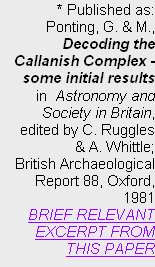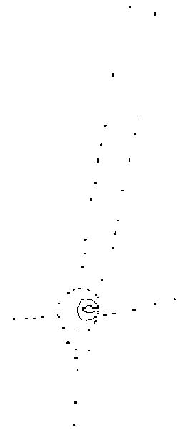
Callanish (Calanais)
Isle of Lewis, Scotland
- pages by
Gerald Ponting
Isle of Lewis, Scotland
- pages by
Gerald Ponting

The moon rises from the hills of the ‘Sleeping Beauty’ ...
... skims across the southern horizon and above the stones of the east row ...
... and, as seen from the north end of the avenue, sets, then re-appears within the circle.

BACK TO TOP

Click anywhere on plan for a larger version
The moon’s furthest south in its current cycle occurred on 29th September 2006, when it had a maximum negative declination of minus 29.6415 degrees. (This figure is specific to the latitude and longitude of Callanish). This declination gives an altitude of just under 2.5 degrees at due south, so that the moon appeared very close to ground level. On that date the moon was 43% illuminated and the moonset was in early evening.
The moon, however, reaches positions nearly as far south as this in months before and after the maximum. The spectacle of the moon among the stones is more impressive nearer full moon and during the hours of darkness, even if the moon is slightly higher. Thus many visitors picked dates in June and July 2006 (and even early and late June in 2007) in the hope of clear weather for the ‘southern moon skim’.
The next opportunity will be in 2025 !
The movements of the moon, in relation to the horizon, pass through a cycle lasting 18.6 years. At the extremes of that cycle, the moon rises and sets at horizon positions which are further north and, a fortnight later, further south than the sun ever reaches. At northern latitudes, this is even more pronounced; and so it is that at Callanish on these rare occasions, the moon just skims the southern horizon for a few hours either side of midnight.
At the Stones, the moon appears to rise out of the hills of the ‘Sleeping Beauty’ and to skim the horizon (see my June 2006 photographs of this event). Some hours later, for viewers standing at the north end of the avenue, the moon sets, then briefly re-appears between the stones of the central circle. The ‘re-gleam’ effect may be seen in photographs taken by M & R Curtis in 1987.
Prehistoric peoples undoubtedly had a deep understanding of the sky and it is possible that observation of this rare event was ‘built into’ the design of Callanish; in prehistoric times, the moon would have been a little lower than this.
The link between the extreme southern path of the moon, the hills of the Sleeping Beauty and moonset among the stones of the Callanish circle was first announced * by Gerald Ponting and Margaret Curtis (then Margaret Ponting) at an archaeo-astronomy conference in 1980.
Web-site created by Gerald Ponting using Serif WebPlus X2
Latest revision of this page March 2009






